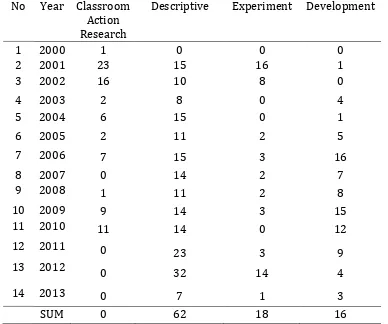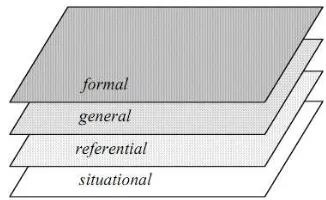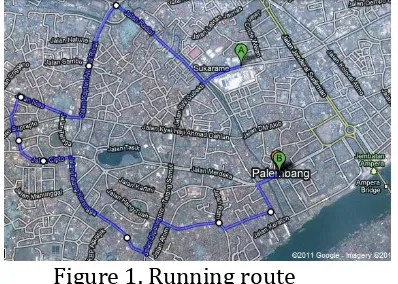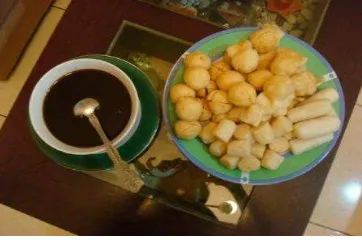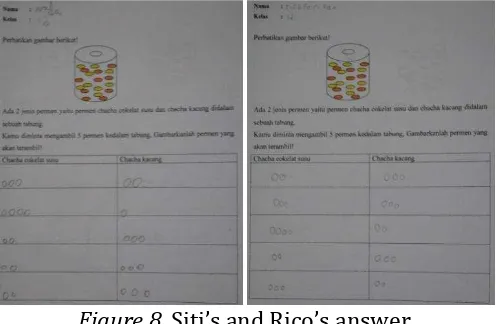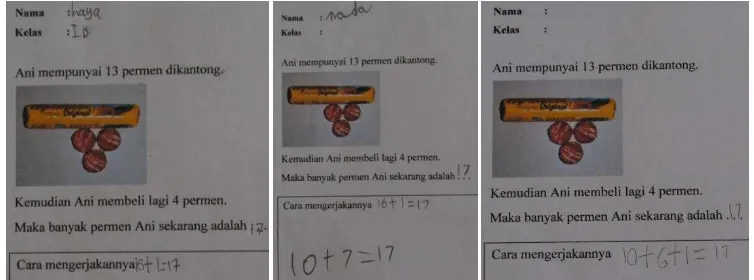22
THE ROLE OF MODEL IN DESIGN RESEARCH
AT SRIWIJAYA UNIVERSITY
Training and Education, Sriwijaya University, especially on the field of mathematics education from 2000 to 2013. As a part of the plenary panel, this paper focuses on the role of model and context in the design research. At the end, some examples of the role of models are described.
Key words: Role of model, design research, SEA-DR conference, Sriwijaya University
Introduction
The first international conference of South East Asia of Design/Development Research (SEA-DR) has been done in Palembang Indonesia. This paper is a part of plenary panel session. It described and discussed about variation of research conducted by under graduate students from 2000-2013 at the Sriwijaya University. Also, it gave some examples the use of models in design research.
A research is one of the ways to find the answer and validity of certain problem. There are some ways to show something such that it has truth-value, for instance, we can notice from the simplest level which is fairy tale, and then it moves to experience, inductive thinking, deductive thinking and scientific method. The way to obtain the truth-value through the scientific method is called as a research. The essence of all research originates in curiosity a desire to find out how and why things happen, including why people do the things they do, as well as whether or not certain ways of doing things work better than others (Fraenkell & Wallen, 2012).
In many countries the quality of education seems to have declined over the past several decades, just when educational research had supposedly begun to accumulate enough knowledge for its findings to make an impact. Many of us who advocate design research believe that it has the potential, in conjunction with standard forms of inquiry, to produce the kind of impact research has made in other areas of life (Walker, 2006).
In order to create interventions, designers need to study how students and teachers actually respond to specific features of the design suggested by the theory. In other words, to show that a design rigorously implements principles from research and theory, designers must do design research (Walker, 2006). The design of educational materials is a crucial part of the research and aims at the investigation of how the design works. Thus, the intertwining of design and theory development is an essential feature of this approach (Van Eerde, 2013).
23 Education (FKIP), Sriwijaya University (Unsri), from 2000 to 2013, many research projects have been done.
The information of research data in study program of mathematics education FKIP Unsri for Under Graduate 2000-2013.
Table 1. Skripsi Data in Mathematics Education 2000-2013
No Year Classroom Action Research
Descriptive Experiment Development
1 2000 1 0 0 0
2 2001 23 15 16 1
3 2002 16 10 8 0
4 2003 2 8 0 4
5 2004 6 15 0 1
6 2005 2 11 2 5
7 2006 7 15 3 16
8 2007 0 14 2 7
9 2008 1 11 2 8
10 2009 9 14 3 15
11 2010 11 14 0 12
12 2011 0 23 3 9
13 2012 0 32 14 4
14 2013 0 7 1 3
SUM 0 62 18 16
Table 1 shows that the research of under graduate students in Mathematics Education FKIP Unsri have already used design research as an approach since 2000. From 2006 to 2008, the post graduate students in Mathematics Education FKIP Unsri had already generated thesis. The following data shows a number of theses of post graduate students in Mathematics Education FKIP Unsri.
Table 2. Theses Data in Mathematics Education FKIP Unsri
No Year Classroom
Action Research
Descriptive Experiment Development Design
1 2008 0 0 0 3 0
2 2009 4 0 3 21 0
3 2010 7 0 4 23 0
4 2011 6 0 5 28 13
5 2012 1 0 0 38 9
6 2013 0 0 0 2 8
24 According to the information from table 2, we can see that post graduate students have already generated the product through the development research and design research.
Importance of Model
Emergent models bridge the gap between informal knowledge and formal abstract strategies (Carpenter, 1997). Emergent models play in bridging the gab between informal knowledge and formal mathematics.
The models refer to concrete situations, which are experientially real for the students. When the students has more experience with similar problems, their attention may shift towards the mathematical relations and strategies. As a consequence, the model becomes more important as a base for mathematical reasoning than as a way to solve the problem. In this situation, the model started to become a referential base for the level of formal mathematics. Or in short, a model of
informal mathematical activity develops into a model for more formal mathematical reasoning.
Gravemeijer elaborated the model of and model for distinction by identifying four general types of activity (Gravemeijer, 1994), as shown in the following figure.
Figure 1. Levels of mathematical activity
The implementation of the four general types of activities in this study is described as follows.
1) Situational activity, in which interpretations and solutions depend on the understanding of how to act and to reason in the setting.
2) Referential activity, in which model of refer to activity in the setting described in instructional activities.
3) General activity, in which model for refer to a framework of mathematical relations.
4) Formal mathematical reasoning which is no longer dependent on the support of
models for mathematical activity.
Example of Research in Unsri Using Design Research
According to (Octavarulia, at all, ) with the title Investigating the progress of Indonesian fifth grade students’ learning on multiplication of fractions with natural numbers .
The implementation of the four general types of activities in this study is described as follows.
(1) Situational activity, In this level, within the problem of locating flags and
25 explore their informal knowledge of partitioning when they were asked to divide a certain length into some equal parts.
Figure 1. Running route
Note: image is taken from http://maps.google.com/
At the same time, students were listening the following story:
To prepare running competition in the celebration of Indonesian Independence Day, Ari and Bimo practice their running skills. They plan to run from Palembang Indah Mall (point A) to Palembang municipality office (point B) following the running route. Eight flags and 6 water posts are stored on the track to know the position where Ari and Bimo will stop. Flags are placed on the running route with the same distance. The water posts also are placed on the running route with the same distance. The last flag and the last water post are stored at the finish line (in front of Palembang municipality office).
(2) Referential activity, Students’ activities might be considered referential when
they were initially use tools (yarn) as a representation of running race route. In this study, the activity of notating fractions in the empty fractions cards and putting fractions cards on the string of yarn also served as referential activity in which students produced their own fractions to represent their way in making construction of partitioning. In this activity, the number line as a representation of string of yarn became the model of measuring situation.
Figure 2. Fraction cards hang on the string of yarn
(3) General activity, the model for more mathematical reasoning in this present study was the reasoning of relationship among fractions i.e. the equivalent fractions through the use of number line. In this activity, number line was introduced as a generalization tool of string of yarn.
26 this moment, the double number line could be used as a helpful tool to find the distance that could be covered by two runners where their locations were known with the help of flags and water posts.
Figure 3. Relation between 3 8
and 1 8
in the number line
(4) Formal mathematical reasoning which is no longer dependent on the support of models for mathematical activity. The focus of the discussion moves to more specific characteristics of models related to the concepts of equivalent fractions, fractions as numbers and fractions as multipliers.
The String of Numbers
Figure 5. Fractions as multipliers
According to thesis (Hainul, at all, 2011) with the title developing mental calculation strategies for addition problems in grade of primary school .
These levels of emergent modeling in this research can be described as follows: 1. Situational level
The real contextual situation which is taken into classroom activities such as
making combinations of ten pempek will provide informal knowledge of students in learning addition. In this level, students are still able to see and use the real objects.
The activity in the lesson I of preliminary experiment is that students are challenged to make combinations of ten pempek. First, we showed them a picture of pempek (Figure 5)to get willing that they knew about this contextual situation.
27 Since first grade students could not visualize those combinations, we initiated to make pempek from wax (figure 6) and asked them to experience with it.
Figure 6. Pempek from wax
2. Referential level
In this research, the representations of pempek will serve as models-of situations.
we gave them a paper to draw combinations of ten mpek-mpeks. The result is that the students come up with some different drawing as follows:
Figure 7. Inaya’s and Bimo’s drawing
3. General level
Students make general representations such as circles to represent candies and eggs become model-for situation. In this level, the circles are independent from students’ thinking in the real contextual situation (Figure 8).
Figure 8.Siti’s and Rico’s answer 4. Formal level
28
Problem:
Ani has 13 candies in her pocket, and then she get 4 more candies, so how many candies does Ani have now?
Figure 9.Inaya’s, Siti’s, and Bimo’s answer
From the example of design research above, it shows that model that is used by students to solve the problem based on the level of student itself in understanding and interpreting the given problem.
REFERENCES
Carpenter, 1997. (1997). Model for reform of mathematics teaching. In M. Beishuizen, K.P.E. Gravemeijer & E.C.D.M. van Lieshout (Eds), The Role of contexts and models in the development of mathematics strategies and procedures. (pp. 35-54). Utrecht: CD β Press.
Fraenkell & Wallen, (2012). How to design and evaluate research in education. The Graw-Hill. New York.
Gravemeijer, K. (1994). Developing Realistic Mathematics Education Research Group on Mathematics Education. Utrecht: CD β Press.
Octavarulia, N, Hartono, Y., Ilma, R. de Haan (2011). Investigating the progress of indonesian fifth grade students’ learning on multiplication of fractions with natural numbers. IndoMS-JME, 2(2), pp.147-162
Hainul, Z., Darmawijoyo, Ilma R., den Hertog (2011). Design research on addition: supporting indonesian first graders to develop mental calculation strategies on addition up to 20. Unpublish Thesis.Palembang:Sriwijaya University.
Van Eerde, (2013). Design research: looking into the heart of mathematics education. In Zulkardi (Eds). Proceeding of International Conference The First of SEA-DR. Palembang:Sriwijaya University.
Walker, (2006). Toward productive dsign studies . In Akker J., Gravemeijer, K., McKenney, S. & Nieveen, N. (eds). Educational Design Research (pp. 8-14). London: Routledge.
This paper can be cited as Zulkardi(2013). Proceeding The First South East Asia Design/Development Research (SEA-DR) International
